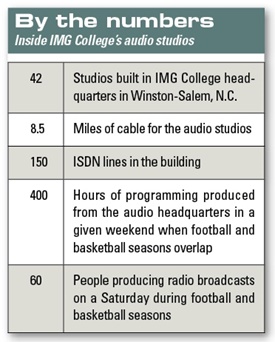The tranquil streets of Winston-Salem, N.C.’s downtown arts district are nearly barren on a fall Saturday in November. But behind the doors at IMG College is a beehive of broadcasting activity that will feed the nation much of its college football and basketball on this day.
The occasional passer-by curiously peers into the front window, where one of IMG College’s showcase studios is visible from the sidewalk. It’s just a small taste of what’s happening deeper inside the company’s headquarters, from which up to 400 hours of broadcasting are produced on a weekend when football and basketball overlap.
 |
IMG College’s 42 studios produce up to 400 hours of radio broadcasts on a weekend.
Photo by: JULIE KNIGHT PHOTOGRAPHY
|
It wasn’t that long ago that every college football and basketball radio broadcast was executed remotely, with the production and sound originating on-site in college towns like Athens, Ga., or Pullman, Wash. Now, on a fall Saturday when the seasons overlap, as many as 60 radio broadcasts are produced inside IMG College’s headquarters. The play-by-play still comes live from the game site, but the music, commercial spots, highlights and other sound is mixed in by producers at the centralized studios in Winston-Salem.
In one sound cubicle, producer Cabell Philpott works the soundboard, cues up the advertising and provides score updates during sponsored breaks on Georgia’s eight-hour broadcast, counting pregame and postgame. For Georgia’s 12:30 p.m. kickoff, Philpott reported for work at 7:30 that morning and the pregame broadcast went live at 8:30. He has one of the longest days of any of the producers.
In another cubicle close by, Tony Castricone does the same for listeners of the Notre Dame broadcast. Later on, producers working games for the UCLA and Washington networks will be in the studio until the wee hours of Sunday morning to accommodate the later West Coast start times.
These multitaskers must have the technical know-how to handle production, as well as the radio voice to go on the air when they update listeners with scores and news in the pregame, and during breaks and halftime as the game goes on. While the play-by-play and analyst voices at the stadium focus on the game, the voices in Winston-Salem keep listeners informed with what’s happening around the conference and the country.
Some of the producers are fresh out of college and hoping to launch a career. ESPN’s Carter Blackburn started this way, as did Cory Provus, voice of the Minnesota Twins. Others use the weekend work to supplement their income from other jobs. One young producer travels from Ohio to Winston-Salem each weekend just to get the air time.
More than 40 studios are spaced throughout the first floor of IMG College’s 50,000-square-foot headquarters. Some will be used multiple times on a given Saturday to accommodate up to 60 broadcasts.
Learfield, another large multimedia rights holder, has a similar approach; 22 studios produce games at its Jefferson City, Mo., headquarters. In November, the number of games produced on a Saturday at Learfield can range from 30 to 40 given the overlap of football and basketball.
“The intent has been to corral all of our audio into one place so that we can better control the sound and the branding of the broadcasts,” said Chris Ferris, vice president of audio at IMG College. The audio division encompasses all sound that goes to radio, online or mobile apps.
Before IMG College moved into its new office in Winston-Salem’s downtown arts district in 2007, it had a much smaller studio location in a house off Country Club Road just north of downtown. But when IMG College President Ben Sutton built the new headquarters, he included ample studio space, which already has been expanded. The studios take up a significant portion of the first floor in the three-floor building.
From that centralized location will come more than 30,000 hours of radio programming — everything from games to coaches’ shows — during the course of the year. That programming goes out to most of IMG’s 80-plus college clients and their radio affiliates.
On a recent weekend of football and basketball programming, the button was hit on more than 12,000 commercial spots. In a year, these broadcasts bring in close to $100 million in ad support across all of the schools, the company said.
“We can control the spots and the sound, whereas if we had 60 broadcasts being produced from 60 different locations, it would be a lot more difficult to manage,” Ferris said.
The radio broadcast is just a portion of what multimedia rights holders do for schools nowadays. Twenty-five years ago, before rights holders were selling integrated sponsorships, signage and hospitality packages, the radio broadcast of football and basketball games was all that they had to sell. That’s how Learfield’s college business got started, broadcasting Missouri games. Jim Host started Host Communications — later it was acquired by IMG College — by broadcasting Kentucky games.
Radio broadcasts now are but a piece of a much larger media and marketing puzzle for companies like Learfield and IMG College, but they remain one of the most important ways for a school to connect with its fan base.
The Georgia broadcast is among the longest, with four hours of pregame, a three-hour game and an hour of postgame. South Carolina’s pregame is three hours.
By centralizing most of its radio broadcasts at the IMG College headquarters, the company has an easier time auditing the ads that run and creating monthly reports that are sent back to the advertiser. Without the centralized method, account reps would have to call 60 different producers.
“Producing broadcasts from our own studios means we have a pool of talent and resources working together to offer sponsors consistently high-quality programming,” said Doug Gillin, senior vice president, collegiate property sales at IMG College. “With that comes the ease of centralized trafficking and administration.”





